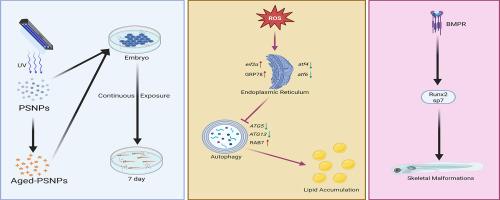老化的纳米塑料重编程内质网应力自噬串扰:斑马鱼骨骼畸形的机械通道
IF 4.3
2区 环境科学与生态学
Q1 MARINE & FRESHWATER BIOLOGY
引用次数: 0
摘要
微(纳米)塑料(MNPs)在水生环境中普遍存在,由于环境风化,老化的MNPs是主要形式。然而,它们的发育毒性,特别是对骨骼形成的毒性,仍然知之甚少。本研究通过48小时的紫外线照射制备了老化的聚苯乙烯纳米塑料(psnp),并将其与斑马鱼胚胎中受精后4小时(hpf)和持续7天的原始psnp进行了比较。原始和老化的PSNPs都会引起骨骼畸形,但老化的PSNPs会造成更严重的影响,包括孵化率降低、死亡率增加和幼虫体长改变。组织病理学分析显示肌纤维组织紊乱,卵黄囊内脂质堆积。两组患者均观察到活性氧(ROS)和钙离子水平升高。老化的psnp显著上调GRP78和RAB7蛋白的表达,增加内质网应激(ER应激)标志物eif2α的转录,下调参与骨发育的关键基因(bmp2b, bmp4)和自噬(atg13, atg5)。这些发现表明,衰老的psnp会加剧氧化应激,激活内质网应激途径,抑制自噬,损害骨骼发育。本研究强调了环境老化MNPs的高度发育毒性,并强调了将老化塑料颗粒纳入生态风险评估的必要性。本文章由计算机程序翻译,如有差异,请以英文原文为准。

Aged nanoplastics reprogram the ER stress-autophagy crosstalk: A mechanistic gateway to skeletal malformations in zebrafish
Micro(nano)plastics (MNPs) are pervasive in aquatic environments, with aged MNPs being the predominant form due to environmental weathering. However, their developmental toxicity, particularly regarding skeletal formation, remains poorly understood. In this study, aged polystyrene nanoplastics (PSNPs) were prepared via 48-hour UV irradiation and compared with pristine PSNPs in zebrafish embryo exposures starting within 4 h post-fertilization (hpf) and lasting for 7 days. Both pristine and aged PSNPs induced skeletal malformations, but aged PSNPs caused more severe effects, including decreased hatching rates, increased mortality, and altered larval body length. Histopathological analysis revealed disrupted muscle fiber organization and lipid accumulation in the yolk sac. Elevated reactive oxygen species (ROS) and calcium ion levels were observed in both treatment groups. Aged PSNPs significantly upregulated GRP78 and RAB7 protein expression, increased transcription of the Endoplasmic Reticulum stress (ER stress) marker eif2α, and downregulated key genes involved in bone development (bmp2b, bmp4) and autophagy (atg13, atg5). These findings indicate that aged PSNPs exacerbate oxidative stress, activate ER stress pathways, inhibit autophagy, and impair skeletal development. This study highlights the heightened developmental toxicity of environmentally aged MNPs and underscores the necessity of including aged plastic particles in ecological risk assessments.
求助全文
通过发布文献求助,成功后即可免费获取论文全文。
去求助
来源期刊

Aquatic Toxicology
环境科学-毒理学
CiteScore
7.10
自引率
4.40%
发文量
250
审稿时长
56 days
期刊介绍:
Aquatic Toxicology publishes significant contributions that increase the understanding of the impact of harmful substances (including natural and synthetic chemicals) on aquatic organisms and ecosystems.
Aquatic Toxicology considers both laboratory and field studies with a focus on marine/ freshwater environments. We strive to attract high quality original scientific papers, critical reviews and expert opinion papers in the following areas: Effects of harmful substances on molecular, cellular, sub-organismal, organismal, population, community, and ecosystem level; Toxic Mechanisms; Genetic disturbances, transgenerational effects, behavioral and adaptive responses; Impacts of harmful substances on structure, function of and services provided by aquatic ecosystems; Mixture toxicity assessment; Statistical approaches to predict exposure to and hazards of contaminants
The journal also considers manuscripts in other areas, such as the development of innovative concepts, approaches, and methodologies, which promote the wider application of toxicological datasets to the protection of aquatic environments and inform ecological risk assessments and decision making by relevant authorities.
 求助内容:
求助内容: 应助结果提醒方式:
应助结果提醒方式:


